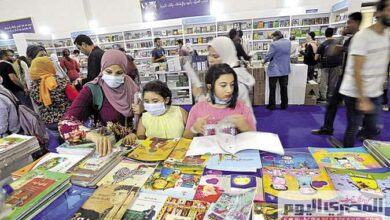Last Saturday in a lush garden just across el-Mansouriya road from the pyramids, a large crowd gathered to celebrate the release of The Arabian Horse of Egypt, a debut book featuring photographs by breeder Nasr Marei “celebrating the history and splendor of this special breed.” The garden belonged to Marei, who is also the third-generation owner of Albadeia Stud Farm in Giza and the co-founder and vice chairperson of the Egyptian Arabian Horse Breeders Association. His oversized 21 by 25 cm book features 160 pages of glossy photographs along with writings on the evolution and preservation of the breed in Egypt by Arabian horse historian, Cynthia Culbertson. The book is glowingly introduced by Princess Alia Bint Al Hussein of Jordan. It is a coffee table book with a pedigree.
The partygoers’ chic attire—linen suits and wide-brimmed hats—identified them as horse lovers more than even a pair of muddy riding breeches would. An elderly woman in long pants the color of sweet spring peas, reminisced about her childhood surrounded by horses. “My father said that every man must know how to ride a horse. When I bring this up to my husband, he changes the subject.”
Mark Linz, the director of Marei’s publisher, AUC Press, whinnied into the microphone to corral the mingling crowd away from the stables and the canapés, and Marei addressed the group. Albadeia Stud Farm has been in operation since 1935, raising mares and stallions–prizewinners on both the national and international scene–that Marei had been photographing long before “the dream” of this book became a reality. If his love for his horses was not made clear by the photographs—rich, dramatically lit portraits of the animals often gracefully mid-stride, widening their dark, intimidating eyes—it was explicit in his remarks. The animals which he described as “the noblest creatures on earth” captured his attention as a photographer hoping to “portray the magic and mystique of this amazing creature.” Marei got his first camera at a young age, but when the humans around him grew weary of his habit, he made horses his subjects, “trying to freeze them in their exploding energy and movement.” He also promised that later they would dance.
Soon enough the first horse, a black stallion in a saddle pierced with silver buttons and a tasseled necklace, appeared in the garden, picking up his sturdy legs in a dance that was half-foxtrot, half nervous maneuverings around a rain puddle. Its focused rider held tight to the reins, while a band played Egyptian music.
Following the dancing portion, the garden pathway became an equestrian runway, with only a soft whip to the ground and the shaking of an air-filled plastic bag to the side to point Marei’s model horses in the right direction. Marei assured the crowd that the trainer’s whips never touch the horse’s body during any part of its training. It’s an assurance made believable by the split focus of the book: on beauty, yes, but also on respect for the breed that, as recently as 1961, was nearly extinct. It was Marei’s grandfather, then the Minister of Agriculture, who convinced the socialist government to preserve the Arabian horse. Letting the breed die out, he argued, would “be as if we are erasing the great pyramids of Egypt.”
Marei’s photographs capture ‘human’ emotion in the animals, whose broad, tense backs and dark, flared nostrils can be frightening at first. It is the eye of someone who not only breeds the animals, but also knows them well. Two half brothers, presented together, took on the personalities of sparring siblings when Marei revealed that their father, who was “on lease for three years in Europe” was due to return home. A three-month-old was introduced with an acknowledgment of his childhood flaws, which Marei was certain he would outgrow to perfection.
It seemed inevitable that the awkward young horse would eventually become a winner, but Marei’s book is not simply a catalogue of champions. By showing his horses clomping on straw or whipping their heads in moonlight or arching their long necks away from the camera, he celebrates not their value as purebred Arabians, but their beauty—and, yes, their “noble mystique”—as wild animals.
Books




